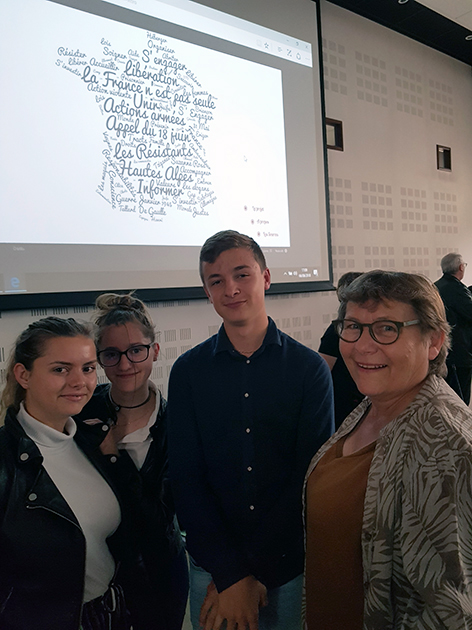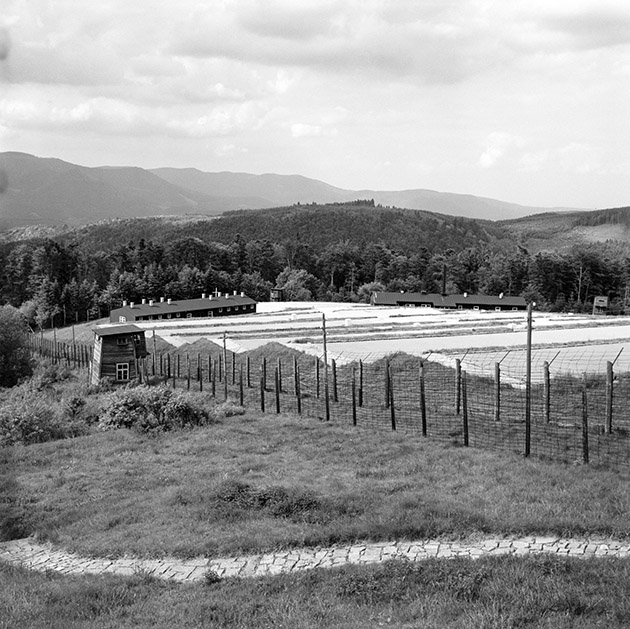A teacher’s view: interview with Régine Phisel

Régine Phisel teaches history and geography at Collège Marie Marvingt in Tallard (Hautes-Alpes). In an educational project that received support from the Ministry of the Armed Forces Directorate for Heritage, Remembrance and Archives (DPMA), she taught her students about the memory of deportation, by inviting them to think about the traces left behind by history in the former Natzweiler-Struthof camp.

Régine Phisel surrounded by her students. © G. Petit-Blanc
What place does the history of deportation have in the school syllabus today?
The history of deportation is taught in 3ème (age 14-15), at the beginning of the school year, as part of the theme “Europe, a major theatre of total war”, which looks at the period 1914-45.
The deportation of resistance fighters, Jews and gypsies is included in the chapter on the Second World War, and is presented as characterising the war of annihilation waged by Nazi Germany in Europe. The topic is looked at in greater depth in première(age 16-17), and the memory of deportation is studied in terminale (final year, age 17-18) at the general lycée.
Thus, four hours of the history syllabus can be devoted to looking at the Second World War. However, cross-curricular project work with French is a way of looking at the topic in more depth. Autobiographical accounts are at the heart of the literature syllabus in 3ème and provide an opportunity to explore various first-hand testimonies. While some students discovered If This is a Man by Primo Levi, my 3ème students read Simone Veil’s A Life in their French class.
What did your teaching and students get out of the visit to Struthof?
The visit to Struthof was a continuation of our classroom learning about deportation. Planned in class, the visit of the site makes today’s teenagers aware of this harsh reality. It is an emotional experience. Our students describe how it gives them the shivers. The atmosphere is oppressive. It is no ordinary place. People suffered there.

Natzweiler-Struthof concentration camp, in Alsace. © Roger-Viollet
Evoking life in the camp and reading archive documents in the very place where that human suffering took place definitely made more of an impression on students than simply reading about it in class. Actually stepping on the concentration camp floor and visualising the conditions of life and death of deportees disturbs students and confronts them with a reality that cements the history of the period and the site in their minds, and leads them to develop their thinking about the history of the 20th century and its violence. This also helps them to get a better grasp of the importance of the engagement of countless resistance fighters, who risked their lives to defend values which today form the cornerstone of the French republic.
Why did you ask your students to photograph the site?
The school trip was a continuation of the work begun by students for the Concours National de la Résistance et de la Déportation competition, on “Engaging to liberate France”. So it seemed natural to invite any who were interested to enter the competition for best photograph of a remembrance site, organised by the Fondation de la Résistance, Fondation pour la Mémoire de la Déportation and Fondation Charles de Gaulle.
This photographic work, whose main aim is to give students the chance to express their artistic sensibility, also served as a resource for the whole group to fix in their minds the sites they had visited and prepare a short slide show on the theme of our trip. The project “Wars, peace and today’s world” was an opportunity to discover first Verdun, then the Struthof concentration camp, before crossing the Rhine on foot over the Pont de l’Europe in Strasbourg and visiting the European Parliament. The idea was for students to expand on our topic work on engagement, as part of their artistic and cultural education and their “citizenship pathway”, and give them the chance to present their work on engagement in the oral examination for the National Diploma (Brevet des Collèges).
Photo taken at the former Natzweiler-Struthof camp by Jean Plugia, a student of Collège Marie Marvingt.
Some students were new to taking photographs, especially with a proper SLR camera. “But what am I supposed to take pictures of? I could use one of my classmates’.” Once I had gone over the personal nature of the photography project with him, the student began to look around him through different eyes and asked to borrow the school camera, while taking pleasure in showing the pictures he had taken.
Two other students chose to use the school’s SLR camera from the word go, because they took a more artistic approach to the task. Watching them at work was a real pleasure.
Do you think it is necessary to preserve the traces left in the landscape by such a dark and painful past? Are these scarred landscapes an important resource for teachers?
Seeing how the students look, feel and approach these remembrance sites confirms me in my belief that we need to preserve the traces of the past in our landscape. It is worth stressing the remarkable work carried out today to make these sites, which bear witness to our country’s darkest hour, accessible to all. The preservation of part of the sites, a reminder of the historical context and the opportunity to reflect and discuss make these sites highly formative for young citizens. The museological efforts of the various sites visited by our students (Struthof, Camp des Milles and Verdun) really enable us to carry out some crucial work on remembrance

